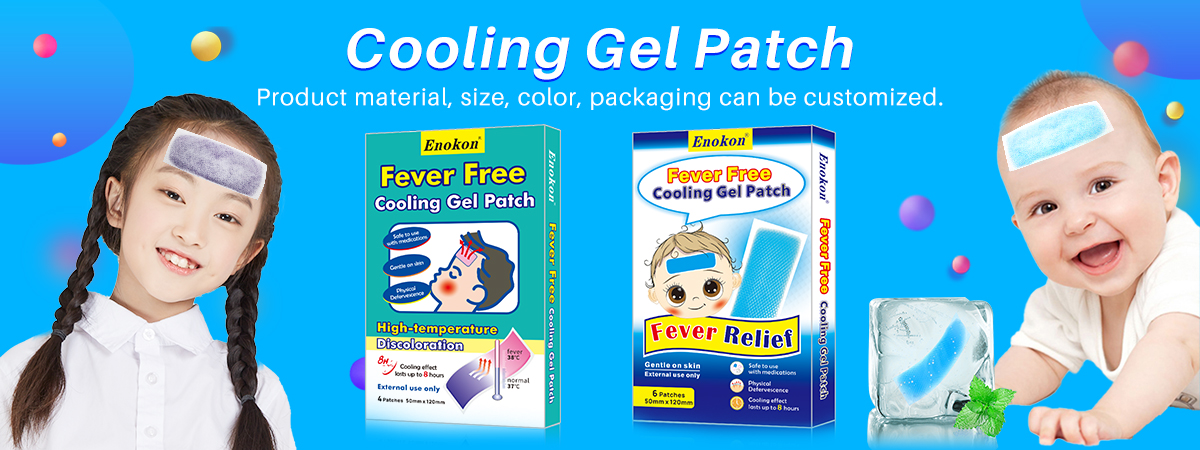
Fever, or pyrexia, is a common physiological response to infections and various illnesses. While it is a natural defense mechanism, the discomfort it brings—headaches, body aches, and general malaise—can be debilitating, especially for children. In the realm of managing fever symptoms, fever relief patches have emerged as a popular, accessible, and non-invasive tool. This article delves into the composition, suitable users, distinctive features, and crucial precautions associated with these widely used products.
Understanding what a fever patch is made of is key to appreciating how it works. Contrary to some misconceptions, these patches do not contain medication that is absorbed into the bloodstream to reduce systemic fever. Instead, they are physical cooling agents.
The primary component is a hydrogel polymer. This polymer is a water-absorbent material that can hold a significant amount of water, glycerin, and other cooling substances. When assembled, the patch consists of several layers:
Backing Layer: A flexible, waterproof plastic film that holds the entire patch together.
Hydrogel Matrix: The core of the patch, this gel layer is infused with water and often additional ingredients like menthol, camphor, or herbal extracts such as peppermint oil. These additives create a prolonged cooling sensation on the skin.
Release Liner: A protective sheet that is peeled off before application to expose the adhesive gel.
Adhesive Layer: A skin-friendly, hypoallergenic adhesive that allows the patch to stick securely to the forehead or other body parts without causing irritation upon removal.
The mechanism is purely physical. As the gel layer is exposed to the body's heat, the water and other volatile substances within it slowly evaporate, drawing heat away from the skin's surface in a process known as evaporative cooling. This provides localized, soothing relief.
Fever patches are designed for a broad audience but are particularly favored in specific demographics:
Infants and Children: This is the primary user group. For parents, managing a child's fever can be stressful, especially when the child is restless or refuses oral medication. A fever patch offers a gentle, external method to provide comfort. Many patches are designed with child-friendly shapes and colors.
Adults: Adults also use these patches for relief from fever-related headaches and discomfort. They are convenient for use at work or during the night to facilitate more restful sleep.
The Elderly: For older individuals who may be on multiple medications, a non-pharmacological method to alleviate fever symptoms can be a beneficial complementary approach.
It is crucial to note that while patches are safe for most, they should never be used on newborns under three months of age without explicit medical advice. For any age group, a fever exceeding a certain threshold (e.g., 104°F or 40°C) or persisting for more than a couple of days warrants immediate medical attention.
The popularity of fever patches stems from a combination of user-centric features:
Non-Invasive and Drug-Free: They provide comfort without introducing chemicals into the body, making them an excellent choice for individuals who cannot tolerate oral antipyretics or for use alongside prescribed medication.
Prolonged Action: A single patch can typically provide a cooling effect for up to 8 hours, offering sustained relief.
Portability and Ease of Use: They are lightweight, discreet, and do not require water or any special preparation, making them ideal for travel, school, or the workplace.
Soothing and Comforting: The cooling sensation directly addresses the burning feeling associated with fever, which can have a significant psychological benefit, calming both the patient and their caregiver.
To ensure safety and effectiveness, users must adhere to the following precautions:
Complementary, Not Curative: The most critical point to remember is that a fever patch is a symptom reliever, not a cure. It lowers skin temperature locally but does not affect the core body temperature or fight the underlying infection. It should always be used as an adjunct to proper medical care and not as a replacement for antipyretic drugs like acetaminophen or ibuprofen when recommended by a doctor.
Skin Integrity: Do not apply the patch to broken, injured, or inflamed skin. The ingredients could cause further irritation.
Avoid Sensitive Areas: Apply the patch only to intact skin on the forehead, underarms, or groin. Strictly avoid contact with the eyes, mouth, nostrils, and other mucous membranes.
Check for Allergies: Before the first use, especially with patches containing menthol or herbal extracts, perform a patch test on a small area of skin (like the inner forearm) to check for any allergic reaction, such as redness or itching.
Prevent Choking Hazards: For young children, ensure the patch is securely adhered and cannot be peeled off and put into the mouth, as it poses a choking hazard.
Follow Age Recommendations: Always use a product designed for the specific age group. Some patches with higher concentrations of cooling agents may not be suitable for very young infants.
In conclusion, fever relief patches are a valuable tool in the home care arsenal for managing the discomfort of fever. Their unique gel-based composition provides safe, localized, and prolonged cooling relief for children and adults alike. However, their role must be understood correctly: they are a source of comfort that complements, but never replaces, professional medical diagnosis and treatment. Used wisely, they can make the challenging experience of a fever a little more bearable.